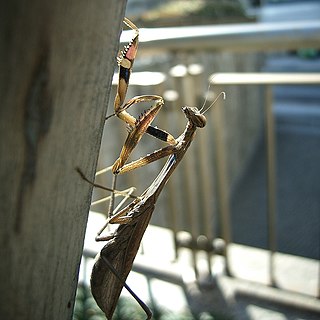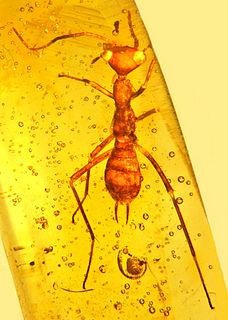
Mantis shrimps, or stomatopods, are carnivorous marine crustaceans of the order Stomatopoda, branching from other members of the class Malacostraca around 340 million years ago. Mantis shrimps typically grow to around 10 cm (3.9 in) in length, while a few can reach up to 38 cm (15 in). The largest mantis shrimp ever caught had a length of 46 cm (18 in); it was caught in the Indian River near Fort Pierce, Florida, in the United States. A mantis shrimp's carapace covers only the rear part of the head and the first four segments of the thorax. Varieties range in color from shades of brown to vivid colors, with more than 450 species of mantis shrimps being known. They are among the most important predators in many shallow, tropical and subtropical marine habitats. However, despite being common, they are poorly understood, as many species spend most of their lives tucked away in burrows and holes.

The Reduviidae are a large cosmopolitan family of the order Hemiptera. Among the Hemiptera and together with the Nabidae almost all species are terrestrial ambush predators: most other predatory Hemiptera are aquatic. The main examples of nonpredatory Reduviidae are some blood-sucking ectoparasites in the subfamily Triatominae. Though spectacular exceptions are known, most members of the family are fairly easily recognizable; they have a relatively narrow neck, sturdy build, and formidable curved proboscis. Large specimens should be handled with caution, if at all, because they sometimes defend themselves with a very painful stab from the proboscis.

Mantidae is one of the largest families in the order of praying mantises, based on the type species Mantis religiosa; however, most genera are tropical or subtropical. Historically, this was the only family in the order, and many references still use the term "mantid" to refer to any mantis. Technically, however, "mantid" refers only to members of the family Mantidae, and not the 14 remaining families of mantises. Some of the most recent classifications have promoted a number of the mantid subfamilies to the rank of family, e.g. Iridopterygidae, Sibyllidae, Tarachodidae, Thespidae, and Toxoderidae, while other classifications have reduced the number of subfamilies without elevating to higher rank.

Gongylus gongylodes, also known as the wandering violin mantis, ornate mantis, or Indian rose mantis, is a species of praying mantis in the family Empusidae. Characterized by extremely slender limbs with large appendages. It is not a particularly aggressive species and often kept as a pet by hobbyists. The mantis is especially known for swaying its body back and forth to imitate a stick flowing in the wind. It primarily feeds on flying insects. Its native range is in southern India and Sri Lanka. It can reach up to 11 cm long. The males of the species are capable of flight. This species is a communal species in that they live and breed in large groups without unnecessary cannibalism.

Ceratopogonidae is a family of flies commonly known as no-see-ums, or biting midges, generally 1–3 mm in length. The family includes more than 5,000 species, distributed worldwide, apart from the Antarctic and the Arctic.

Mantispidae, known commonly as mantidflies, mantispids, mantid lacewings, mantisflies or mantis-flies, is a family of small to moderate-sized insects in the order Neuroptera. There are many genera with around 400 species worldwide, especially in the tropics and subtropics. Only 5 species of Mantispa occur in Europe.

Hymenopus coronatus is a mantis from the tropical forests of Southeast Asia. It is known by various common names including walking flower mantis and (pink) orchid mantis. It is one of several species known as flower mantises from their resemblance and behaviour.

The Bostrichidae are a family of beetles with more than 700 described species. They are commonly called auger beetles, false powderpost beetles, or horned powderpost beetles. The head of most auger beetles cannot be seen from above, as it is downwardly directed and hidden by the thorax. Exceptions are the powderpost beetles, and members of the subfamily Psoinae.

Statilia maculata, common name Asian jumping mantis or "小蟷螂", ko-kamakiri or "좀사마귀", joem-sa-ma-gui, is a species of mantis native to Asia that can be found in China and Japan and Korea and Sri Lanka.
Titanodula grandis, also known as the giant Asian mantis, is a species of praying mantis native to the region around the Bay of Bengal in southern Asia. It is found in Northeast India, Bangladesh, and Myanmar. It is a large mantis which grows up to 6 inches long and is capable of eating small birds, reptiles and mammals.
Amantis aliena is a species of praying mantis native to Myanmar.
Paratoxodera meggitti is a species of praying mantis found in China and Myanmar.
Acromantis hesione, common name Burmese mantis, is a species of praying mantis found in China and the Philippines.
Acromantis nicobarica is a species of praying mantis native to the Nicobar Islands, a part of India near Myanmar.

Ceratomantis saussurii is a species of praying mantis native to Myanmar, Thailand, and Borneo.

Mantises are an order (Mantodea) of insects that contains over 2,400 species in about 430 genera in 30 families. The largest family is the Mantidae ("mantids"). Mantises are distributed worldwide in temperate and tropical habitats. They have triangular heads with bulging eyes supported on flexible necks. Their elongated bodies may or may not have wings, but all Mantodea have forelegs that are greatly enlarged and adapted for catching and gripping prey; their upright posture, while remaining stationary with forearms folded, has led to the common name praying mantis.

Aethiocarenus is an extinct genus of insects which has a single species Aethiocarenus burmanicus described from a 98.79 ±0.62 million year old fossil found in Burmese amber from the Hukawng Valley of Myanmar. The insect is unusual due to the vertex of the triangular head being attached to the pronotum as opposed to the hypotenuse. When first described Aethiocarenus was placed as the sole member of the family Aethiocarenidae and order Aethiocarenodea. However, Aethiocarenus was later considered to be a nymph of Alienopterus. Vršanský et al. (2018) considered Aethiocarenus to be an alienopterid nymph, but considered it distinct from other members of this group and deserving a separate genus rank.












